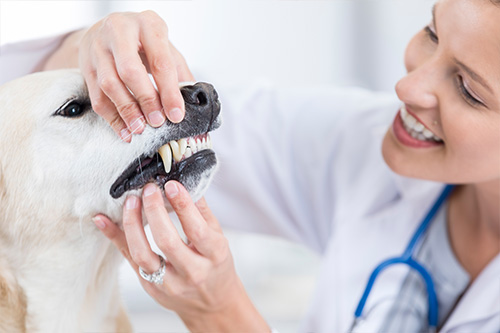
Dental disease is very common in pets, yet there is much that we can do to prevent and/or control it. Statistics show that as many as eighty percent of adult pets have signs of dental disease. Dental disease can cause problems such as chronic pain, loss of attachment of the teeth, recession (shrinking) of the gums and infection of vital organs such as the heart and kidneys. Unfortunately, most pets are very stoic, and they won’t show obvious signs of pain, even when their teeth are causing them a great deal of discomfort. A pet with a sore mouth WILL NOT stop eating (after all, what other choice do they have?), and many people still think that bad breath in a pet is normal. So, most owners don’t notice a problem until the disease has reached an advanced state. Regular dental checkups (performed during your pet’s annual preventive care exam) can make all of the difference in your pets’ oral health.
At this time, the health team will discuss the best ways to help prevent and control dental disease, or, if the dental disease has reached the point where treatment is required, a recommendation may be made to bring your pet in for a Complete Oral Health Assessment and Treatment procedure (COHAT). When your pet is admitted for a COHAT procedure, they will be placed under general anaesthesia, full mouth radiographs (x-rays) will be taken of the teeth to make sure the roots and surrounding bone are healthy, and the teeth will be completely scaled to clean off all plaque and calculus and polished to remove any microscopic scratches that will give bacteria a place to establish themselves. If any other procedures (such as extractions) are necessary, they will be performed at this time. Sometimes, a pet may require advanced dental care such as root canal therapy or orthodontic correction, at which time we can provide a referral to a veterinarian specialized in veterinary dentistry.
Dental X Rays
We are often asked why we take a complete set of dental xrays for every patient that comes in for a dental procedure. The reason is very simple: the part of the tooth that we can actually see is only half (or less!) of the whole tooth! Just like we can’t assess a patient’s health by only examining half of that patient, we can’t tell whether a tooth is free of disease by only looking at the visible parts.
A patient we saw recently is a perfect example of the importance of dental xrays. This patient is a five year old medium-sized dog who has otherwise been in good health. Gingivitis and dental calculus were noted on his annual examination, and there were no external indications of any dental infections or abscesses. His owner scheduled him for a complete oral health assessment and treatment.
The patient was placed under anaesthetic (see the case of Shadow’s spay for more information on anaesthesia), full-mouth dental xrays were taken and the teeth were cleaned and examined.
